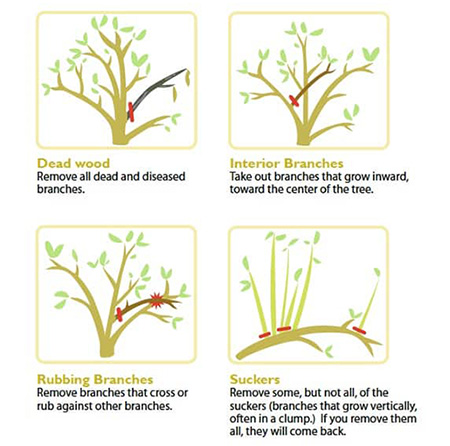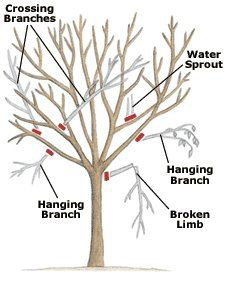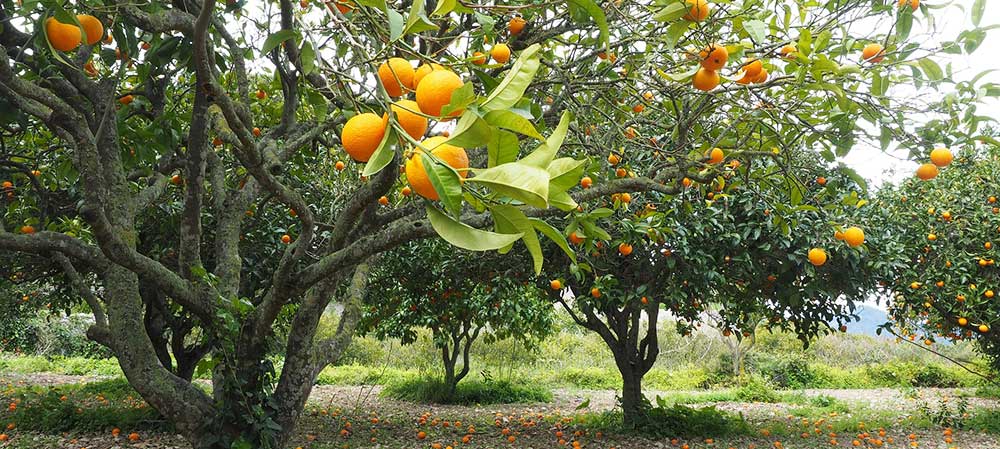Pruning Fruit Trees
Turn an arduous task into a simple one
If left to themselves, fruit trees will quickly overgrow and become a scraggly mess in your otherwise pristine garden. The key to keeping them attractive and productive is annual pruning - which isn't as scary as many make out. You may be told that different fruit trees need to be pruned in different ways, which has some truth to it, but as a basic requirement, there is a simple three-step process that is adequate for the vast majority of fruit trees.
Here in our NZ climate most of us avid home gardeners are dealing with pome fruit (apples, pears, quince) or stone fruit (peaches, cherries, apricots, plums etc). When it comes to pruning any of these, during winter is a good time for two main reasons:
- There is less folliage on the branches and therefore easier to see what you're doing
- More importantly, during this dormant season the tree will store its energy in its roots and when spring comes there will be fewer branches to distrubte this energy to meaning the remaining branches will grow better and produce quality fruit.

Step 1: Clean up and remove
- Prune away any dead, damaged or diseased wood
- Remove small sprouts 'suckers' from the trunk base - these are rootstock rather than the fruiting variety of sprout
- Remove any perfectly vertical small branches/sprouts 'watersprouts' growing on the main branches. Keep q few however as if you remove them all, they will all come back.
- With all the clean-up cuts it's important to prune branches back flush with the larger branch they're growing from
Step 2: Let the light in
- By thinning the branch density more light and air can ciculate in the canopy boosting fruit production and reducing issues with pests and disease.
- Remove downward growing branches or ones that look to be growing towards the centre of the tree
- Remove branches that cross paths with other branches
- Remove any competing branches growing from a single crotch at a narrow angle and retain the healthiest branch.
- Likewise, if two branches are growing parallel., one hovering over the other, remove one, keep one (preferably the most healthiest with crotch angle at 2 or 10 o'clock from the tree centre). Wider angles break easier when laden with fruit, and narrower angles lead to bushy growth with fruit too high to pick.
- Continue to thin the tree until there is about 15-30cm of space around every branch. The smaller the branches are the closer they can be to each other.
- All thinning cuts should be flush with the branch.

Step 3: Head Back
- Now we need to prune back the outermost 20-30% of last year's growth which encourages the branches to grow shorter and thicker. This helps ensure they are strong enough to withstand the weight of the fruit, and may also activate growth lower in the canopy which makes for smaller, more fruitful trees.
- Distinguish last year's growth from two-year-old growth by the wrinkly ring of bark covering each stem. Depending on the tree's vigor, this could be somewhere between 5cm to 1.3m from the branch tip.
- It is important in this step to prune the branch at the correct place. The cut should be made at 0.5cm above a bud that faces the direction you want the brach to grow in the coming year. If there is another branch close by on the left for example, prune back to a bud on the right side of the branch.
One Year Old Tree
Maiden Whip:
(a one year old tree with no side shoots)
- Immediately after initial planting, prune to a bud with two buds below it at about 80cm from the ground. This enables primary branches to be established during the first growing season.
Feathered Whip:
(a one year old tree with several side branches)
- Prune back the main stem to three or four strong shoots at 80cm from the ground.
- Side shoots should be shortened by two thirds of their length to an upward or outward facing bud.
- Lower shoots should be removed flush with the stem.
Two Year Old Tree
- Remove any lower shoots and prune between three and five of the best placed shoots by half, to an upwards or outwards facing bud. This will form what will become the tree’s main structural branches.
- Remove any inwards facing shoots.
Three Year Old Tree
- Select the leading shoots of branches that will help to extend the framework and prune back by half to a bud facing in the desired direction.
- Select four good laterals to fill the framework and shorten these by a half.
- Prune any remaining laterals to four buds to form fruiting spurs.
Four Year Old Tree
- The tree will have begun to fruit and only limited formative pruning is now required.
- Shorten leaders by one third and prune non-required laterals to extend the framework to four buds.
When to Prune
Winter: 
Prune now! Excess energy is stored by your plant in it's root system over winter so if it is pruned during it's dormant period, when it comes to life again in Spring, there will be fewer branches for this energy to be distibuted to. The remaining branches receive an abundance of energy inducing more growth and better quality produce.
Spring: 
Slows growth. With the energy required to produce blossoms and leaves and tree growth much of the stored energy over winter is spent during Spring. Pruning in Spring enables excess energy to be used and so your tree will not grow as vigorously during the rest of the seaon.
Summer: 
More slow growth. Summer pruning will slow growth even more than Spring does as most of the energy has been used in the growth and fruiting periods of Spring/early Summer. Any pruning done now will not result in much new growth at all.
Autumn:
Do not prune! Despite the tree having spent most of its energy during its growth and fruiting of Spring and Summer, prune at any time of the year will spur some growth. These tender new shoots will likely die during the winter frosts leaving wounds that make excellent entry points for pests and diseases.

18785